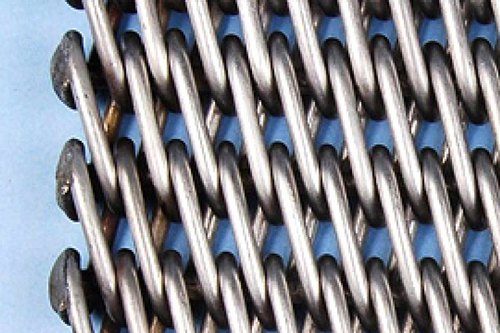
Wire Mesh Belts
| Usage/Application | Industrial |
| Material | SS |
| Weight | 2-5 kg |
| Capacity | 20 kg per feet |
| Corrosion Resistance | Yes |
We are enlisted among the reliable names in the industry for providing an excellent quality range of Wire Mesh Belts Type 7. Available in different sizes, these products are precisely manufactured in compliance with pre-defined business guidelines by our dexterous professionals. Owing to their reliability and durability, these products are widely appreciated and demanded amongst our customers. We offer these products at very competitive prices.
Features:
- Long lasting
- Cost effective
- Unmatched quality
Description:
Wire Mesh Belts are often used in diverse applications. The various weaves of wire mesh belts are describes below. Materials of construction are Stainless Steel / High Carbon Steel /Alloy Steel is decided based on material being conveyed and operating temperature range. Typical application are washing, baking, dewatering, cooling, freezing, pasteurizing, annealing, drying, heat-treating and quenching. Chain driven belts are positive tracking.
Wire Mesh Belts
| Usage/Application | Industrial |
| Material | SS |
| Weight | 2-5 kg |
| Capacity | 20 kg per feet |
| Corrosion Resistance | Yes |
We are enlisted among the reliable names in the industry for providing an excellent quality range of Wire Mesh Belts Type 7. Available in different sizes, these products are precisely manufactured in compliance with pre-defined business guidelines by our dexterous professionals. Owing to their reliability and durability, these products are widely appreciated and demanded amongst our customers. We offer these products at very competitive prices.
Features:
- Long lasting
- Cost effective
- Unmatched quality
Description:
Wire Mesh Belts are often used in diverse applications. The various weaves of wire mesh belts are describes below. Materials of construction are Stainless Steel / High Carbon Steel /Alloy Steel is decided based on material being conveyed and operating temperature range. Typical application are washing, baking, dewatering, cooling, freezing, pasteurizing, annealing, drying, heat-treating and quenching. Chain driven belts are positive tracking.
Wiremesh belts are versatile conveyor solutions constructed from interwoven wire mesh materials, offering durability and flexibility for various material handling applications. These belts come in different construction patterns, such as balanced weave, compound weave, and chain edge, each providing unique characteristics suited to specific conveying needs. Balanced weave belts feature a uniform weave pattern for enhanced strength and stability, while compound weave belts combine different wire mesh configurations for improved flexibility and drainage capabilities. Chain edge belts incorporate metal chains along the edges for added reinforcement and support.
The applications of these belts span across a wide range of industries, including food processing, automotive, electronics, and agriculture. In the food industry, these belts are commonly used for baking, frying, cooling, and freezing processes, thanks to their excellent heat resistance and non-stick properties. In automotive manufacturing, these belts facilitate the handling of hot parts during production, while in electronics assembly, they provide ESD (electrostatic discharge) protection. Additionally, these belts are utilized in agricultural settings for conveying harvested crops, seeds, and fertilizers.
Industries requiring robust, heat-resistant, and hygienic conveyor solutions often rely on these types of belts for efficient material handling. Food processing plants, bakeries, and confectioneries utilize these belts for conveying baked goods, snacks, meats, and dairy products. Similarly, automotive manufacturing facilities employ wiremesh belts for handling hot parts and components during various production stages. Electronics and semiconductor industries also utilize wiremesh belts for conveying delicate components in cleanroom environments, ensuring product integrity and cleanliness.
The advantages of these belts are numerous. Their open mesh design allows for excellent airflow and drainage, making them suitable for applications where moisture removal is critical. Additionally, wiremesh belts offer high tensile strength, heat resistance, and corrosion resistance, ensuring long-term durability and reliability in harsh operating conditions. Their non-stick surface properties make them easy to clean and maintain, reducing downtime and enhancing operational efficiency.
Key parameters for designing these belts include mesh size, wire diameter, belt width, and edge type. These parameters are tailored to specific application requirements such as load capacity, product size, conveyor speed, and operating environment. Additionally, considerations for belt tension, tracking, and drive configuration are essential for optimizing belt performance and ensuring smooth and reliable operation. By carefully evaluating these design parameters, manufacturers can create belts that provide efficient and reliable material handling solutions for various industries.

